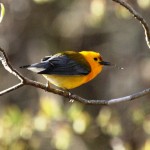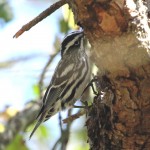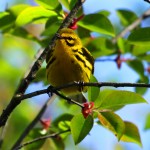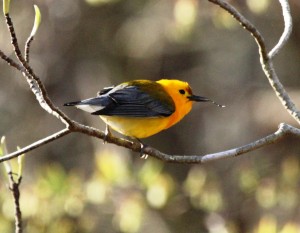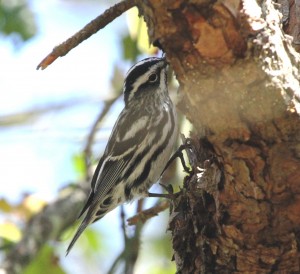New Jersey: A Time for Warblers
By Brian Johnson, Preserve Manager, and Ariel Senko. Photos by Brian Johnson.
This past month, our southern New Jersey preserves have been full of warblers, which are a treat to see in their magnificent breeding plumage. Brian Johnson, New Jersey preserve manager, says that 16 warbler species breed on our southern Jersey preserves and up to 35 species pass through in May, though a few years can pass between sightings of some of the species. The peak season is just about over, but the 16 species that breed on our preserves may be spotted well into the summer.
Neo-tropical migrants, most of the warblers we see in the U.S. winter in Central or Southern America. (Some are satisfied with wintering in southern Florida.) The three varieties pictured here are the Prothonotary Warbler, the Black and White Warbler, and the Prairie Warbler, respectively. As you may notice, the predominant color among warblers is yellow, though they may also sport blues, oranges, reds, greens, greys, black, and white. All warblers consume insects and spiders; a few species have more diverse diets, and will eat berries, seeds, and nuts.
Most warbler species prefer to spend their time high in the trees (the better to catch flying bugs), so experienced birders will often rely on warblers’ songs to help them identify the birds. There is a reason that the aches that birders sometimes experience from staring up for extended periods of time is called “Warbler Neck”—the warblers are so pretty that birders can’t help themselves!
The Prothonotary Warbler
The Prothonotary Warbler is known as the only cavity-nesting Warbler on the East Coast, preferring old woodpecker holes and hollowed trees. Of the three warbler varieties pictured, only the Prothonotary population entirely leaves the U.S. for the winter. Since so many warblers are yellow, it can be tricky to tell them apart at first, but if you see a yellow bird with a full blue/gray wing on our preserves, you can be sure that it’s a Prothonotary. The only other warblers with so much blue on their wings are, well, Blue-Winged Warblers, which have a black band across their eye and aren’t common on this part of the East Coast.
The Black and White Warbler
The Black and White Warbler goes up and down the lengths of tree trunks to hunt for insects on and underneath the bark, much like a Nuthatch or Brown Creeper. These Warblers seem to prefer broadleaf or mixed uplands. Despite spending so much time feeding in trees, Black and Whites prefer to nest on the ground. Their plumage is striking, but their stripes actually help them to blend in with their surroundings, making them easy to miss.
The Prairie Warbler
Prairie Warblers breed in early successional habitats—overgrown fields with sparse, young trees, and prefer to nest in shrubs or trees no more than 10 feet off the ground. Some fun facts about these Warblers—they will sometimes hang upside down on a branch to eat bugs on the undersides of leaves, and are also know to eat the eggshells of their young as soon as the young have hatched.
All three of these Warbler species are rated by the International Union for Conservation of Nature (ICUN) as a species of “Least Concern,” but bird-watching organizations around the country including the National Wildlife Service agree that many Warbler populations, as well as those of many other neo-tropical bird species, are currently declining. Other populations appear to be stable but have concentrated populations, and they may be at risk if those habitats are altered or lost.
Of the three Warblers featured here, the Black-and-White Warbler is doing the best, thanks to its relatively extensive breeding and wintering ranges (from southern Canada through Mexico and Central America into the northwest coast of South America), and the variety of habitats it will tolerate.
Prothonotary Warblers like to live in tree cavities above standing water, which is why they like New Jersey—for the swamps and wetlands. Prothonotaries prefer to nest in larger tracts of forest and are believed to be suffering a loss of habitat due to development and deforestation. The installation of nesting boxes (as substitutes for tree cavities) and efforts to restore bottomland forests along the Mississippi River have led to increased populations in the U.S., but the birds still face loss of habitat in their wintering grounds south of the U.S.
Prairie Warblers, on the other hand, prefer fields with small trees and shrubs. They actually lose habitat as forests naturally mature. The good news is, Natural Lands Trust’s stewardship staff use a stewardship technique that periodically eliminates the young growth of new trees that would result in the gradual loss of the Prairie Warbler’s preferred habitat in certain parts of our preserves—controlled burns. Prairie Warblers, like Prothonotary Warblers, still face loss of habitat in their wintering grounds outside the U.S.
In addition to loss of habitat, many Warblers are also susceptible to pesticides that are used in communities to kill mosquitoes, and parasitism by the Brown-headed Cowbird, which, making no nest of its own, will lay its eggs in Warbler nests. The Cowbird brood, which are usually larger than the Warbler brood, become competition for food from the Warbler parents, and may even remove Warbler eggs and young from the nest. Cowbirds prefer to live in open land near trees, but not in forests, so deforestation has exacerbated the Cowbird parasitism problem.
The main threat to Warblers, however, continues to be loss of habitat in their wintering grounds. Since Congress passed the Neotropical Migratory Bird Conservation Act (NMBCA) in 2002 in order to promote the long-term conservation of neotropical migratory birds and their habitats, millions of dollars have been raised every year to fund collaborative conservation projects in North, Central and South America. This year, $12.5 million was raised to protect more than 250,000 acres of this critical habitat, including pine-oak forests of Central America, critical bays in Panama and Paraguay, high Andean wetlands, the Ecuadorian Choco.

